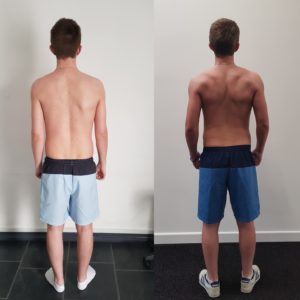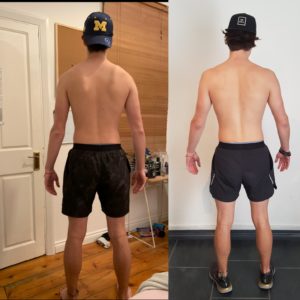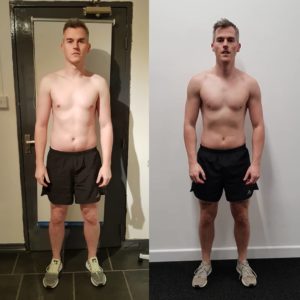Gaining Muscle Mass For ‘Skinny’ Guys
If I flashback to when I first started training, I followed a guy called Gregg Plitt (RIP) pretty religiously. When I thought about gaining muscle mass in my mind he was the guy I would look like by the end of it. For some context, the guy was absolutely ripped to shreds all the time and really muscular.
The reality of gaining muscle is, we are all put together differently when it comes to our genetics and as such will all look slightly different. I will say this now though, DO NOT let genetics put you off or discourage you from trying to gain muscle. The amount of dudes I’ve worked with who look JACKed (cough, cough, branding, cough, cough) now but started off their first session by saying to me “I just never think I’ll be muscular” is all too common.
The likelihood is that if you really want to be muscular, but you are of the opinion it just wont happen for you, is that you haven’t yet got the fundamentals right or explored different ways to make the fundamentals work for you.
That might sound harsh, but 99.9% of the time it simply comes down to not getting the basics right if you can’t gain any muscle on your frame. I don’t say this to get you down, but reassure you that it is nothing complicated. That being said, there may be some worthwhile pre-requisites to starting to gain muscle mass at a decent rate.
The first question we must ask is: are there some pre-requisite things you need to understand and have in place first before you see ‘gains’?
In short….. YES.
So let’s get into it.

(Chris- 7 months apart- 2-3 x training per week)
MEASURING PROGRESS
One of the biggest areas of confusion is actually how to measure to make sure you are making progress. To be honest, I keep this as simple as possible with 3 main body comp measurements along side training progress. These are: weight, cm measurements and body comp pictures.
CM Circumference Measures: Narrowest point around waist, Belly Button, mid thigh (mid point between knee cap and hip crease), Widest point of Calves, Widest point around flexed arm (90* held in front of you), widest point around relaxed arm (point between shoulder and elbow joints, let hang by your side), Chest (nipple line).
Weight: take am weight every morning after a trip to the toilet and before any food/fluids.
Pictures: Once per week, same time, same lighting, front, both sides and back pictures.
What we are ideally looking for is for waist and belly button circumference to stay the same or similar (so we are not gaining too much fat around your mid section), whilst chest, arms, thigh all increase. The waist and belly button may come up slightly as you get deep into gaining, especially if you are giving some attention to building the muscles around your abdominals, but as long as it’s not at a fast rate you’re all good.
Weight wise this should creep up over the weeks. It is hard to tell what rate of gain you will experience, as it can be really individual. However, somewhere between 0.5-1.5% bodyweight increase is likely a good starting point to aim for.
When it comes to body comp pictures, this is a much more subjective area of change, but ideally you are looking to start to see ‘thicker’ looking muscles that take up more space without looking like you are just gaining body fat. Some fat gain is inevitable, so muscle mass may look ‘softer’ at a point.

(Grant- 4 months apart- 4x training per week)
TRAINING
First of all, having an understanding of how your body moves in space, with objects and on machines is really important. Sometimes I see the first 8-10 weeks with slightly slower progress if someone does not have the training experience to understand good positions in training simply because they cannot ‘connect’ with the muscles that are supposed to be trained during an exercise.
This is purely a case of time and experience, which is why I keep things very basic for beginners. You need time to practice both big movements (to feel muscles work in unison) as well as isolating muscles (to feel muscle groups work in isolation). This is far too much of an individual thing to give a definitive answer, as everyone has a slightly different history of movement when they come into the gym.
There are a few worthwhile things to learn, and that is how to properly squat, hinge, push, pull, brace and lunge on the movement side of things. On the isolation side of things, we can look at the main muscle groups we will likely target: calves, quads, hamstrings, glutes, lower/mid/upper back, pecs, abdominal muscles (in all planes, so not just the sexy ones at the front, but the whole group in all directions as they are all important!), biceps, triceps, forearms, front/mid/rear deltoids is a more than substantial list to start with and likely something that really comes more in to play if you have 4+ training sessions per week.
“Think of it like baking a cake. The cake itself is the big movements and the icing is the isolation on top. Bake the cake first, then ice it.”
For me, the biggest thing that separates good results from fantastic results is the effort put into training. Intensity doesn’t just represent the weight on the bar, but how you approach every single rep when you are training. This comes with a bit of experience in the gym, but across the board I would want people to be trying to get as much as possible out of every rep in every set. Whether it is a warm-up or a hard working set, approaching your reps with the intent to carry them out with a sense of purpose is what really elevates your training and results.

(Ben- 3 years apart- 3-5x training per week)
NUTRITION
There is one big thing to get right here: CALORIES. In my opinion, it’s harder to gain muscle efficiently that it is to lose body fat. The two main pitfalls that people end up in are either: gaintaining (whoever invented this phrase is a genius) when you just end up spinning your wheels at maintenance and not really making much progress…OR…going absolutely YOLO on the mega bulk and ending up with a load of unnecessary body fat.
The easiest way to make sure you are getting enough or too many calories in, is to track your calories. So making this a habit right from the get go is really important. Sure, it can definitely be done without tracking, but the greatest successes I have seen with gaining mass have all been with people who have had a clear idea of how much they were taking in. The more you know, the greater control you have to adjust things and still make progress. You wouldn’t just hazard a guess at your speed past a speed camera and this is exactly the same.
Take your bodyweight in Kg and multiply by 32-36 for a starting point. If I take myself for example here are the numbers:
90 x 32 = 2880
90 x 36 = 3240
I would recommend starting at the bottom of this range and working up by 10% after 2 weeks if you don’t see any muscle gain. Hold it there for another 2 weeks and see what happens, repeat with 5-10% extra calories until you start seeing progress.
Next up, it is a good idea to start thinking about your protein intake. Somewhere between 1.6-2.2g/Kg is absolutely fine and probably not necessary to go any higher than the top end of that. So if I take myself for example:
90 x 1.6 = 144
90 x 2.2 = 198
range = 144-198g of protein p/day
Now, what I would recommend however is keeping a tighter range than this just for the sake of consistency. See where you fall most comfortably and aim for a 10g range from there.
When it comes to carbohydrates and fats, let them make up the rest of your calories as you please. Generally this wont impact body composition too much, however there is some nuance in your choices rather than just cramming as many big macs in to your day as possible. I would like most people to go slightly higher on the carbs, purely because of the performance benefits of having easier access energy for your body in training. However, if it is the difference of hitting calories or not, ramping up fats a little will certainly help in that department!
Food quality is well worth considering here too. Whilst calories are king, we still want to take care of our health in the process of gaining mass. I would recommend you try to get most of your foods from whole foods (fruits, vegetables, grains, meat, fish, dairy, oils, nuts, seeds, animal fats). From these you can think about covering the bases with the usual big boxes to tick for health- eat veg and protein at every meal, as minimally processed food as possible and drink plenty of water.
That being said, there may be times where slightly more processed foods can help you to meet calorie and protein targets. For those times, I suggest you have things like granola, whey protein, bread, jam, honey, nut butters, oats, ground rice, full fat dairy and high calorie cereal to hand. I’ve found when I’ve been working with guys who struggle to put on mass that after a workout and just before bed are good times to get some extra calories in, so those are the times where the foods suggested can come in handy.

(Noah- 2.5 months apart- training 3-4 x per week)
RATE OF CHANGE
When it comes to rate of change, it depends on a few things.
- Your experience with training and nutrition – if you need to learn and educate yourself on these first, the first few weeks may not see as fast progress as weeks 6-8 onwards just as you get to terms with the fundamentals. If you have a greater understanding and experience, but have just never committed to a consistent plan then you may well see progress a lot faster.
- How many times a week you can train – I would recommend most of you do 3-4 sessions a week. 5-6 sessions may well be absolutely perfect for you, but only if you can manage to recover from that amount of training. More does not always equal better, better equals better. For example if you cannot recover properly from 5 sessions a week, 4 may well serve you a lot better. You can still make progress on 2 sessions a week, but it will likely be slower than if you could do 3-4 sessions.
- What is your lifestyle like? – essentially we are talking about stress management here. The amount of progress an 18 year old lad who is on his 16 week summer break can make will be much different from the dad with 2 kids who can only just manage 3 sessions a week between work, school runs, out of school clubs and housework. Think of stress like a big jug of water. Every time something causes you stress (training, work, social stress, financial stress, lack of sleep, too much coffee, alcohol) you are emptying the jug. Every time you are relaxing and recovering (sleeping, eating, down time, social relaxation, hot baths, sauna, massage, reading) you are filling up the jug. There will be times when we want the jug to be more on the empty side if there is a particularly hard push, e.g. towards a holiday when you want to look especially JACKed (cough, cough, more branding, cough, cough). But largely we want a balance between the two.

(Chris- front view- same timeframe as above)
BODY COMPOSITION – 3 FAQ’S
When do you actually start to look ‘Jacked’?
Your new body composition will start to show in time, exactly how much I cannot say for definite. But provided you are getting the fundamentals right: training progressively, eating enough calories and measuring and adjusting every few weeks, you should start to see muscle growth within a 12 week period. For some that might seem like a long time, but muscle growth just takes longer than fat loss.
Steve Hall (from Revive Stronger) compared building muscle to riding a bike up a steep hill and fat loss to riding the same bike downhill. Regardless of how much effort you put in, it just takes time. Granted that could be less time if you can commit to doing more, or more time if you cannot commit to doing as much.
Although it may not be the nugget of magic you want to hear, you just have to get going and see what sort of rate you can push your progress at. If your not happy with how fast you are gaining, try upping calories and keep pushing yourself hard in training…equally if you aren’t happy because you are gaining too fast and thus gaining unnecessary body fat, drop calories a little but keep training hard.
Can you ‘lean bulk’?
The term ‘lean bulk’ gets thrown around a lot and I think it confuses people. It’s almost a suggestion that there are two different kinds of ‘bulking’- a lean one and a fat one? I think everyone trying to gain muscle should be trying to gain as little fat as possible while they do it, as anything other than that could be really counter productive and just add on unnecessary time to ‘dieting’ excess body fat off later.
A lot of phrases get thrown around by people that mean well, but perhaps don’t know how to best explain information in an accessible way. All a ‘lean bulk’ is, is just a successful period of time gaining muscle without gaining too much fat.
So yes, you can and I believe you should, but let’s stop implying that there’s a ‘lean’ and ‘not-lean’ way to do it. You either do it sensibly, or stupidly…to put it bluntly.
How can I fit short term goals into long term goals?
Periodisation is a word you may or may not have come across before. All it means is having designated periods of time where you have a main focus and perhaps a secondary focus that compliments the first. For example a mass building phase for 24-32 weeks, with a secondary goal of seeing squat, bench, deadlift, military press and barbell row strength increase. Following this you might drop calories slightly to maintain your new bodyweight before either going again for a mass building phase or dieting for a designated period of time to drop body fat.
Ultimately your short terms goals should resonate with the purpose you are actually doing any of this in the first place. If you aren’t driven to do the work in the short term for what you really want in the long term, then you are either unclear on your path forwards or the goal is not in line with your personal values.
For me, short term goals take care of the ‘motivation’ in seeing week on week progressions (in whichever way that is, from nailing all your food, to adding weight on the scale, to adding weight on the bar etc) whilst long term goals keep that fire underneath you burning.

(Ben during his first ever photoshoot at Pioneer Performance)
WRAPPING UP
A lot of you who struggle to add muscle mass are often just lacking some consistency with the fundamentals. Progressive overload, calories and accountability to making sure those things are in check so measurements keep progressing. Get the basics right and you should be adding slabs of mass at a steady rate.
So let’s stop the gaintaining, yolo bulking and complaining about how our genetics are getting in our way… and start being sensible, purposeful and mindful about how we add muscle mass. Do it smart, properly and patiently and you’ll be thanking yourself big time in 12 months. If it’s worth doing, it’s worth doing well and you probably have more potential than you realise!
Hopefully this post has helped clear up some of the noise when it comes to getting JACKed (might as well get the branding in one last time aye…) and if it is something that has really resonated with you, I am opening space to take on one new in person client before 2020 kicks off.
This is for someone who wants to achieve what the guys above have achieved, in building slabs of muscle mass and getting stronger than ever. If it is something that would interest you, fill out the contact form on the website home page or drop me an email at jack.curtis.pt@gmail.com to see if we would be a good fit to work together.
